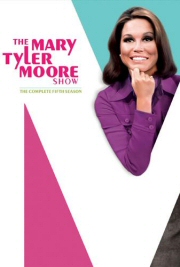- Comedy
- 1974
- Buy the DVD
Reviewed by Ross Ruediger
()
ust about every piece of criticism I’ve ever read about “The Mary Tyler Moore Show” (or just plain “Mary Tyler Moore,” which is the title in the opening credits) goes to great lengths to talk about how it’s one of the greatest sitcoms in TV history. Maybe it is. Maybe it’s not. When you start attaching the label “greatest” to pieces of pop culture, there tend to be expectations involved, and surely that’s the case if the viewer is new to the show. I’ve got a massive amount of unconditional love for “Mary Tyler Moore,” but I watched this particular set with a more critical eye than I normally would, and tried to be a little bit more objective throughout my viewing.
The truth is that a fair amount of this series is horribly dated by today’s standards. What made the show so groundbreaking at the time – the idea of a career woman making it on her own without the help of a man – today seems awfully quaint and naïve. Further, there’s a great deal of sexism that pops up from time to time. Sometimes, when it’s from anchorman Ted Baxter (Ted Knight), it’s appropriately funny because Baxter is supposed to be a clueless buffoon. Other times, however, it comes from Mary’s boss, Lou Grant (Edward Asner), and it’s these instances that may very well have the power to get under people’s skin. Lou wasn’t like Ted, or even Archie Bunker for that matter: he was an intelligent, decent man, and a good boss, so it becomes all the more obnoxious when Mary is still expected to get him his coffee. In this season, when Mary is promoted to producer, she has to beg Lou to give her more responsibility; in his mind, giving her the title was plenty. Much of the series is probably an accurate reflection of what single career-minded women were going through in the ‘70s, so it’s really important to take all that into context when watching the show.
Once you strip away the show’s core mission, however, what you really have is a genuinely charming and funny sitcom that manages to induce at least a couple big belly laughs per episode, alongside a fair amount of chuckles, and will result in a permanent grin being plastered on your face throughout. The show may have had a feminist mission, but it rarely got ugly or political or particularly heavy, unlike much of the more issue-driven fare Norman Lear was making at the time. Lear had his strengths, and James L. Brooks and Allan Burns had theirs, which was to create a series that was mostly about forming a family out of your friends and co-workers. It may sound a bit like TV cliché now, but this was one of the first series to pull this off successfully, without having some sort of wacky premise to prop up the show (i.e. “Gilligan’s Island”).
Season Five was the first season without Mary’s best friend Rhoda Morgenstern, who’d gone off to New York to have her own TV show, “Rhoda.” For most any other series, this would be a massive hurdle to overcome, since the Mary/Rhoda dynamic was integral to the structure of the show. But “Mary Tyler Moore” had such a talented team of writers creating such a rich group of characters that were being played by such an expert team of actors that you don’t even notice Rhoda’s gone. (Natch, the fact that it’s been over three years since Season Four was released on DVD could be coloring my view.) The season sees Mary spending even more time around the office and with her co-workers, and yet since her personal life, specifically her famous apartment, are also core to the show, Lou, Ted, and copywriter Murray (Gavin MacLeod) are far more prone to just “stop by” her residence for unusually intrusive reasons. (Heck, in one episode, “Neighbors,” Lou goes so far as to move into Rhoda’s old apartment).
Again, though, it’s such an effortless endeavor to extend this series massive amounts of good will that you pretty much just find yourself going along with it, as you do when Mary spends more time with Ted’s girlfriend, Georgette (Georgia Engel), even though the two seem to have nothing in common. Where the writers really amp up the season is in giving far more screen time to WJM’s man hungry and manipulative Happy Homemaker, Sue Ann Nivens (Betty White). White is an absolute scream in this season and really comes into her own as a character (she’d only been showcased a handful of times the previous year). Anytime she’s absent from an episode, you almost want to skip to the next one, hoping she’ll be there.
One of the best episodes of the season is “Not a Christmas Story,” in which the staff is trapped together at the station due to a snowstorm, and they progressively begin getting on each other’s nerves, and the whole thing ends hilariously with a Christmas feast prepared by Sue Ann. “The New Sue Ann” is another great one that pulls an “All About Eve” when a young girl starts as Sue Ann’s assistant, and ends up climbing the ladder quite efficiently. The standout of the season, however, is probably “Ted Baxter’s Famous Broadcasters’ School,” and it would be criminal to tell you anything about it; the title is all you need to know.
On the downside, there are also a few installments that don’t work as well as the others. “I Love a Piano” struck a few sour notes, as it shows Murray contemplating having an affair, which just seems so un-Murray. Another one, “An Affair to Forget,” is an episode to forget. In it, Ted starts a rumor around the station that he and Mary are having an affair; baffling idea for a story on this show, and much of the sexism I complained about earlier is at an all-time high in this one. The good episodes far outweigh the duff ones, though, so don’t take my words as any kind of indication that this season is a mixed bag, because it quite simply is not. I don’t know if “The Mary Tyler Moore Show” is actually one of the greatest sitcoms of all time, but it’s certainly one of my favorites.
Special Features: Near as I can tell, all 24 episodes are presented in their complete and uncut forms and with the same level of audio and video quality as the previous seasons. This in itself is probably all fans really want, since for the longest time there was the feeling that we’d never see Seasons Five through Seven on DVD. Unfortunately, you’ll have to console yourself that that’s as good as it gets. The rest of the presentation is pretty underwhelming. There are no special features whatsoever. The individual slipcovers that housed the discs of the previous season sets are gone, and now all three discs are enclosed in one plastic case. There is no episode guide – not even an insert – to tell you which episodes are on which discs. The DVD menus present the episode titles in an incredibly tiny font, and folks with poor eyesight will probably find them difficult to navigate. And just to prove that nobody was really paying attention to the cover artwork, the back of the box claims that Valerie Harper is still one of the stars of the show, yet it makes no mention of either Betty White or Georgia Engel, even though there’s a picture of both of them displayed right above the cast list.
You can follow us on Twitter and Facebook for content updates. Also, sign up for our email list for weekly updates and check us out on Google+ as well.













